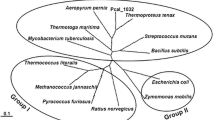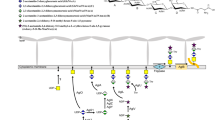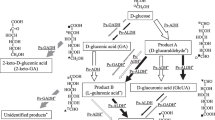Abstract
The hyperthermophilic sulfate-reducing archaeon Archaeoglobus fulgidus strain 7324 has been shown to degrade starch via glucose using a modified Embden-Meyerhof pathway. The first enzyme of this pathway, ADP-dependent glucokinase, was purified 600-fold to homogeneity. The enzyme is a monomeric protein with an apparent molecular mass of 50 kDa. It had a temperature optimum at 83 °C and showed a significant thermostability up to 100 °C. The enzyme was highly specific for ADP and glucose as substrates; it did not use ATP, CDP, UDP, or GDP as phosphoryl donors, or mannose, fructose and fructose 6-phosphate as phosphoryl acceptors (at 80 °C). Only glucosamine was phosphorylated at significant rates. The apparent K m values for ADP and glucose (at 50 °C) were 0.07 mM and 0.78 mM, respectively; the apparent V max value was about 50 U/mg at 50 °C and 350 U/mg at 80 °C. Divalent cations were required for maximal activity; Mn2+, Mg2+ and Ca2+, which were most effective, could be replaced partially by Cu2+, Ni2+, Co2+ and Zn2+. The N-terminal amino acid sequence (42 amino acids) of ADP-dependent glucokinase was almost identical to that of ADP-dependent glucokinase from Thermococcus litoralis. In the genome of the closely related Archaeoglobus fulgidus strain VC16 a homologous gene for ADP-dependent glucokinase could not be identified.




Similar content being viewed by others
References
Beeder J, Nilsen RK, Rosnes JT, Torsvik T, Lien T (1994) Archaeoglobus fulgidus isolated from hot North Sea oil field waters. Appl Environ Microbiol 60:1227–1231
Bradford MM (1976) A rapid and sensitive method for the quantitation of microgram quantities of protein utilizing the principle of protein-dye binding. Anal Biochem 72:248–254
Brunner NA, Brinkmann H, Siebers B, Hensel R (1998) NAD+-dependent glyceraldehyde-3-phosphate dehydrogenase from Thermoproteus tenax. The first identified archaeal member of the aldehyde dehydrogenase superfamily is a glycolytic enzyme with unusual regulatory properties. J Biol Chem 273:6149–6156
De Vos WM, Kengen SW, Voorhorst WG, van der Oost J (1998) Sugar utilization and its control in hyperthermophiles. Extremophiles 2:201–205
Hansen T, Reichstein B, Schmid R, Schönheit P (2002) The first archaeal ATP-dependent glucokinase, from the hyperthermophilic crenarchaeon Aeropyrum pernix, represents a monomeric, extremely thermophilic ROK glucokinase with broad hexose specificity. J Bacteriol 184:5955–5965
Ito S, Fushinobu S, Yoshioka I, Koga S, Matsuzawa H, Wakagi T (2001) Structural basis for the ADP-specificity of a novel glucokinase from a hyperthermophilic archaeon. Structure 9:205–214
Kengen SW, Tuininga JE, de Bok FA, Stams AJ, de Vos WM (1995) Purification and characterization of a novel ADP-dependent glucokinase from the hyperthermophilic archaeon Pyrococcus furiosus. J Biol Chem 270:30453–30457
Klenk HP, Clayton RA, Tomb JF, White O, Nelson KE, Ketchum KA, Dodson RJ, Gwinn M, Hickey EK, Peterson JD, Richardson DL, Kerlavage AR, Graham DE, Kyrpides NC, Fleischmann RD, Quackenbush J, Lee NH, Sutton GG, Gill S, Kirkness EF, Dougherty BA, McKenney K, Adams MD, Loftus B, Venter JC (1997) The complete genome sequence of the hyperthermophilic, sulphate-reducing archaeon Archaeoglobus fulgidus. Nature 390:364–370
Koga S, Yoshioka I, Sakuraba H, Takahashi M, Sakasegawa S, Shimizu S, Ohshima T. (2000) Biochemical characterization, cloning, and sequencing of ADP-dependent (AMP-forming) glucokinase from two hyperthermophilic archaea, Pyrococcus furiosus and Thermococcus litoralis. J Biochem(Tokyo) 128:1079–1085
Labes A, Schönheit P (2001) Sugar utilization in the hyperthermophilic, sulfate-reducing archaeon Archaeoglobus fulgidus strain 7324: starch degradation to acetate and CO2 via a modified Embden-Meyerhof pathway and acetyl-CoA synthetase (ADP-forming). Arch Microbiol 176:329–338
Laemmli UK (1970) Cleavage of structural proteins during the assembly of the head of bacteriophage T4. Nature 227:680–685
Meyer C, Schmid R, Scriba PC, Wehling M (1996) Purification and partial sequencing of high-affinity progesterone-binding site(s) from porcine liver membranes. Eur J Biochem 239:726–731
Ronimus RS, Morgan HW (2001) The biochemical properties and phylogenies of phosphofructokinases from extremophiles. Extremophiles 5:357–373
Sakuraba H, Yoshioka I, Koga S, Takahashi M, Kitahama Y, Satomura T, Kawakami R, Ohshima T (2002) ADP-dependent glucokinase/phosphofructokinase, a novel bifunctional enzyme from the hyperthermophilic Archaeon Methanococcus jannaschii. J Biol Chem 277:12495–12498
Selig M, Xavier KB, Santos H, Schönheit P (1997) Comparative analysis of Embden-Meyerhof and Entner-Doudoroff glycolytic pathways in hyperthermophilic archaea and the bacterium Thermotoga. Arch Microbiol 167:217–232
Stetter KO (1988) Archaeoglobus fulgidus gen. nov., sp. nov.: a new taxon of extremely thermophilic archaebacteria. Syst Appl Microbiol 10:172–173
Stetter KO (1996) Hyperthermophilic procaryotes. FEMS Microbiol Rev 18:149–158
Tsuge H, Sakuraba H, Kobe T, Kujime A, Katunuma N, Ohshima T (2002) Crystal structure of the ADP-dependent glucokinase from Pyrococcus horikoshii at 2.0-A resolution: a large conformational change in ADP-dependent glucokinase. Protein Sci 11:2456–2463
Tuininga JE, Verhees CH, van der Oost J, Kengen SW, Stams AJ, de Vos,WM (1999) Molecular and biochemical characterization of the ADP-dependent phosphofructokinase from the hyperthermophilic archaeon Pyrococcus furiosus. J Biol Chem 274:21023–21028
Verhees CH, Tuininga JE, Kengen SW, Stams AJ, van der OJ, de Vos WM (2001) ADP-dependent phosphofructokinases in mesophilic and thermophilic methanogenic archaea. J Bacteriol 183:7145–7153
Acknowledgements
The authors thank H. Preidel for mass culturing Archaeoglobus fulgidus strain 7324 and R. Schmid (Osnabrück) for the determination of N-terminal amino acid sequence. This work supported by Grants from the Deutsche Forschungsgemeinschaft (SCHO 316/8-1) and the Fonds der Chemischen Industrie.
Author information
Authors and Affiliations
Corresponding author
Rights and permissions
About this article
Cite this article
Labes, A., Schönheit, P. ADP-dependent glucokinase from the hyperthermophilic sulfate-reducing archaeon Archaeoglobus fulgidus strain 7324. Arch Microbiol 180, 69–75 (2003). https://doi.org/10.1007/s00203-003-0563-2
Received:
Revised:
Accepted:
Published:
Issue Date:
DOI: https://doi.org/10.1007/s00203-003-0563-2




